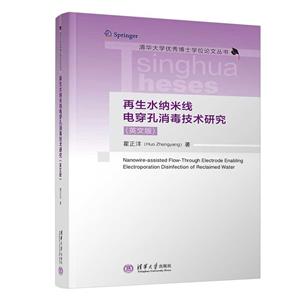-
>
公路車寶典(ZINN的公路車維修與保養秘籍)
-
>
晶體管電路設計(下)
-
>
基于個性化設計策略的智能交通系統關鍵技術
-
>
花樣百出:貴州少數民族圖案填色
-
>
山東教育出版社有限公司技術轉移與技術創新歷史叢書中國高等技術教育的蘇化(1949—1961)以北京地區為中心
-
>
鐵路機車概要.交流傳動內燃.電力機車
-
>
利維坦的道德困境:早期現代政治哲學的問題與脈絡
再生水納米線電穿孔消毒技術研究(英文版) 版權信息
- ISBN:9787302617075
- 條形碼:9787302617075 ; 978-7-302-61707-5
- 裝幀:一般膠版紙
- 冊數:暫無
- 重量:暫無
- 所屬分類:>
再生水納米線電穿孔消毒技術研究(英文版) 本書特色
《再生水納米線電穿孔消毒技術研究(英文版)》研究工作解決了現有消毒技術效率低、微生物易復活、消毒副產物多等難題,具有重要的理論意義和應用價值。
再生水納米線電穿孔消毒技術研究(英文版) 內容簡介
《再生水納米線電穿孔消毒技術研究(英文版)》基于多孔電極內部過濾處理模式開發了納米線電穿孔消毒技術,可利用納米線很好強電場實現在極低電壓下對再生水中微生物的高效滅活。內容包括:1. 開發內部過濾納米線電穿孔消毒技術,實現低電壓安全消毒;2. 揭示納米線電穿孔消毒技術可抑制滅活細菌復活的重要規律;3. 發現采用高頻交流供電(10E6 Hz)模式可有效延長電極使用壽命。研究工作解決了現有消毒技術效率低、微生物易復活、消毒副產物多等難題,具有重要的理論意義和應用價值。 《再生水納米線電穿孔消毒技術研究(英文版)》可供高等院校環境工程、市政工程、電化學等專業的研究人員使用,也可供相關領域的工程技術人員參考。
再生水納米線電穿孔消毒技術研究(英文版) 目錄
Chapter 1Introduction
1.1Research background
1.1.1Significance of wastewater reclamation
and reuse
1.1.2Necessity of wastewater reclamation
and reuse
1.1.3Challenges of the existing disinfection
technology
1.2Electroporation disinfection
1.2.1Electroporation for biomedical application
1.2.2Electroporation for water disinfection
1.3Current research status of novel electroporation
disinfection
1.3.1Nanowireassisted electroporation for water
disinfection
1.3.2Current reactor for nanowireassisted
electroporation disinfection
1.3.3Methods for insitu nanowire fabrication
1.3.4Impact of the nanowire morphology on
electroporation disinfection
1.3.5Nanomaterial strengthening method and electrode
lifetime improvement method
1.3.6Treatment efficiency of nanomaterialenabled
disinfection technology for reclaimed
wastewater
1.4Research topics to be further investigated
1.5Research objective and content
1.5.1Research objective
1.5.2Research content
1.5.3Research roadmap
Chapter 2Development of nanowiremodified electrodes and investigation
of the microbial inactivation performance
2.1Research background
2.2Experimental materials and methods
2.2.1Experimental reagents
2.2.2CuO nanowiremodified copper foam electrodes
fabrication and disinfection device
construction
2.2.3Characterization of CuO nanowiremodified
copper foam electrodes
2.2.4Microbes and water samples used in
experiments
2.2.5Nanowireassisted electroporation for microbial
disinfection
2.2.6Bacterial storage after nanowireassisted
electroporation disinfection
2.2.7Free chlorine detection and current detection
during nanowireassisted electroporation
disinfection
2.2.8Copper ion concentration detection
2.2.9Bacterial morphology analysis
2.2.10Bacterial staining experiments
2.3Fabrication of CuO nanowiremodified copper
foam electrodes
2.4Disinfection efficiency of CuO nanowiremodified copper
foam electrodes
2.4.1Disinfection efficiency of E.coli.
2.4.2Disinfection efficiency of E. faecalis, B.subtilis,
and secondary effluent from municipal wastewater
treatment plants
2.4.3Current fluctuations and free chlorine generation
during the disinfection process
2.5Bacterial inactivation mechanisms of nanowireassisted
electroporation disinfection
2.5.1Cell morphology analysis
2.5.2Bacterial staining analysis
2.6Bacterial population fluctuations during the storage
process after disinfection
2.6.1Bacterial population fluctuations during the
storage process
2.6.2Structural analysis of bacterial morphology
during storage after lowdosage nanowireassisted
electroporation disinfection
2.6.3Summary of the tendency of bacterial changes
during storage after disinfection
2.7Summary of this chapter
Chapter 3Effect of the nanowire morphology and electrode structure
on microbial inactivation
3.1Research background
3.2Experimental materials and methods
3.2.1Experimental reagents
3.2.2Preparation of porous electrodes modified with
nanowires of different morphologies
3.2.3Construction of nanowireassisted electroporation
disinfection devices with different electrode
structures
3.2.4Characterization of CuO nanowiremodified
copper foam electrode
3.2.5Microbes and water samples used in
experiments
3.2.6Nanowireassisted electroporation for microbial
disinfection
3.2.7Investigation of the disinfection contribution
of positive and negative electrode and
optimization of the reactor design
3.3Investigation on the effect of CuO nanowire morphology
on bacterial disinfection
3.3.1Factors impacting the morphology of
CuO
nanowires
3.3.2Study on the impact of CuO nanowire
morphology on bacterial disinfection
3.4Investigation on the effect of electrode structure on
bacterial disinfection
3.4.1Investigation of the effect of electrode pore
size on bacterial disinfection
3.4.2Investigation of the effect of electrode thickness
on bacterial disinfection
3.5Investigation on the effect of electrode arrangement
on bacterial disinfection
3.5.1Contribution of positive and negative electrodes
to microbial inactivation during nanowireassisted
electroporation disinfection
3.5.2Reactor optimization to enhance electroporation
disinfection efficiency
3.6Summary of this chapter
Chapter 4Fabrication of highdurability nanowiremodified electrodes
and investigation of their microbial
disinfection performance
4.1Research background
4.2Experimental materials and methods
4.2.1Experimental reagents
4.2.2Fabrication of Cu3P nanowiremodified copper
foam electrode
4.2.3Construction of nanowireassisted electroporation
disinfection devices
4.2.4Characterization and elemental analysis
of
nanowiremodified electrode
4.2.5Microbes and water samples used in
experiments
4.2.6Cu3P nanowireassisted electroporation for
microbial disinfection
4.2.7Analysis of microbial inactivation
mechanisms
4.2.8Analysis of the disinfection efficiency using
nanowiremodified electrodes for
longterm operation
4.2.9Analysis of the loss mechanism of electrode
during longterm operation
4.3Fabrication and characterization of Cu3P
nanowiremodified electrodes
4.3.1Fabrication of Cu3P nanowiremodified
electrodes
4.3.2Characterization of Cu3P nanowiremodified
electrodes
4.4Disinfection efficiency and mechanism of nanowire
assisted electroporation using Cu3P nanowiremodified
electrodes
4.4.1Disinfection efficiency of nanowireassisted
electroporation using Cu3P nanowiremodified
electrodes
4.4.2Disinfection mechanisms of nanowireassisted
electroporation using Cu3P nanowiremodified
electrodes
4.5Longterm disinfection performance and electrode
loss mechanism
4.5.1Longterm disinfection performance of Cu3P
nanowiremodified electrodes
4.5.2Electrode loss phenomenon during the
longterm operation
4.5.3Loss mechanism of Cu3P nanowiremodified
electrode
4.6Summary of this chapter
再生水納米線電穿孔消毒技術研究(英文版) 作者簡介
霍正洋,清華大學環境學院工學博士。現受Korea research fellowship資助于韓國成均館大學先進材料科學與工程學院任研究教授。清華大學優秀博士畢業生。于高水平SCI期刊發表論文20余篇。研究領域:納米材料在環境中應用,基于納米發電機新型環境凈化技術,高效消毒技術,再生水生物風險評價與控制。
- >
詩經-先民的歌唱
- >
隨園食單
- >
月亮虎
- >
名家帶你讀魯迅:故事新編
- >
名家帶你讀魯迅:朝花夕拾
- >
中國人在烏蘇里邊疆區:歷史與人類學概述
- >
新文學天穹兩巨星--魯迅與胡適/紅燭學術叢書(紅燭學術叢書)
- >
我與地壇















